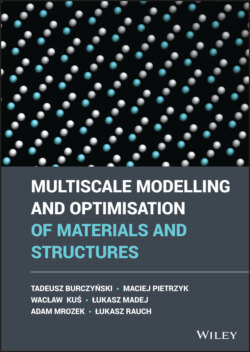Multiscale Modelling and Optimisation of Materials and Structures

Реклама. ООО «ЛитРес», ИНН: 7719571260.
Оглавление
Tadeusz Burczynski. Multiscale Modelling and Optimisation of Materials and Structures
Table of Contents
List of Tables
List of Illustrations
Guide
Pages
Multiscale Modelling and Optimisation of Materials and Structures
Preface
Biography
1 Introduction to Multiscale Modelling and Optimization
1.1 Multiscale Modelling. 1.1.1 Basic Information on Multiscale Modelling
1.1.2 Review of Problems Connected with Multiscale Modelling Techniques
1.1.3 Prospective Applications of the Multiscale Modelling
1.2 Optimization
1.3 Contents of the Book
References
2 Modelling of Phenomena
2.1 Physical Phenomena in Nanoscale
2.1.1 The Linkage Between Quantum and Classical Molecular Mechanics
2.1.2 Atomic Potentials
2.1.2.1 Lennard‐Jones Potential
2.1.2.2 Morse Potential
2.1.2.3 Stillinger‐Weber Potential
2.1.2.4 Reactive Empirical Bond Order (REBO) Potential
2.1.2.5 Reactive Force Fields (ReaxFF)
2.1.2.6 Murrell‐Mottram Potential
2.1.2.7 Embedded Atom Method
2.2 Physical Phenomena in Microscale
2.2.1 Microstructural Aspects of Selection of a Microscale Model
2.2.1.1 Plastometric Tests
2.2.1.2 Inverse Analysis
2.2.2 Flow Stress. 2.2.2.1 Procedure to Determine Flow Stress
2.2.2.2 Flow Stress Model
2.2.2.3 Identification of the Flow Stress Model
2.2.3 Recrystallization
2.2.3.1 Static Microstructural Changes
2.2.3.2 Dynamic Softening
2.2.3.3 Grain Growth
2.2.3.4 Effect of Precipitation
2.2.4 Phase Transformations
2.2.4.1 JMAK‐Equation‐Based Model
2.2.4.2 Differential Equation Model
2.2.4.3 Numerical Solution
2.2.4.4 Additivity Rule
2.2.4.5 Phase Transformation During Heating
2.2.4.6 Identification of the Model
2.2.4.7 Case Studies
2.2.5 Fracture
2.2.5.1 Fundamentals of Fracture Mechanics and Classical Fracture and Failure Hypotheses
2.2.5.2 Empirical Fracture Criteria
2.2.5.3 Fracture Mechanics
2.2.5.4 Continuum Damage Mechanics (CDM)
2.2.6 Creep
2.2.7 Fatigue
References
3 Computational Methods
3.1 Computational Methods for Continuum
3.1.1 FEM and XFEM
3.1.1.1 Principles of Computational Modelling Using FEM
3.1.1.2 Principles of Computational Modelling Using FEM
3.1.1.3 Extended Finite Element Method
3.1.2 BEM and FEM/BEM Coupling
3.1.2.1 BEM
3.1.2.2 Coupling FEM and BEM
3.1.3 Computational Homogenization
3.2 Computational Methods for Nano and Micro
3.2.1 Classical Molecular Dynamics
3.2.1.1 Equations of Motion
3.2.1.2 Discretization of Equations of Motion
3.2.1.3 Temperature Controller
3.2.1.4 Evaluation of the Time Step
3.2.1.5 Cutoff Radius and Nearest‐Neighbour Lists
3.2.1.6 Boundary Conditions
3.2.1.7 Size of the Atomistic Domain – Limitations of the Molecular Simulations
3.2.2 Molecular Statics. 3.2.2.1 Equilibrium of Interatomic Forces
3.2.2.2 Solution of the Molecular Statics Problem
3.2.2.3 Numerical Example of the Molecular Statics
3.2.3 Cellular Automata
3.2.3.1 Cellular Automata Definitions
3.2.4 Monte Carlo Methods
3.3 Methods of Optimization. 3.3.1 Optimization Problem Formulation
3.3.2 Methods of Conventional Optimization
3.3.3 Methods of Nonconventional Optimization
3.3.3.1 Evolutionary Algorithm
3.3.3.2 Artificial Immune System
3.3.3.3 Particle Swarm Optimization
3.3.3.4 Hybrid Optimization Algorithms
References
4 Preparation of Material Representation
4.1 Generation of Nanostructures. 4.1.1 Modelling of Polycrystals and Material Defects
4.1.1.1 Controlled Cooling
4.1.1.2 Adjustable Range of Atomic Interactions
4.1.1.3 Squeezing of the Nanoparticles
4.1.1.4 Modelling of Structures with Voids
4.1.1.5 Material Properties of the Nanostructures
4.1.1.6 Models and Mechanical Properties of 2D Materials with Point Defects
4.2 Microstructure. 4.2.1 Generation of Microstructures
4.2.1.1 Voronoi Tessellation
4.2.1.2 Cellular Automata Grain Growth Algorithm
4.2.1.3 Close‐Packed Sphere Growth CA‐Based Grain Growth Algorithm
4.2.1.4 Monte Carlo Grain Growth Algorithm
4.2.1.5 DigiCore Library
4.2.1.6 Image Processing
4.2.2 Properties of the Microstructure Features
References
5 Examples of Multiscale Simulations
5.1 Classification of Multiscale Modelling Methods
5.2 Case Studies. 5.2.1 Nano–Micro
5.2.1.1 Multiscale Discrete‐Continuum Model
5.2.1.2 Conversion of the Nodal Forces to Tractions
5.2.1.3 Examples of the Nanoscale–Microscale Modelling
5.2.2 Microscale–Macroscale
5.2.2.1 Dynamic Recrystallization
5.2.2.2 Phase Transformation
5.2.2.3 Microshear Bands, Shear Bands, and Strain Localization
References
6 Optimization and Identification in Multiscale Modelling
6.1 Multiscale Optimization. 6.1.1 Optimization of Atomic Clusters
6.1.1.1 Introduction to Optimization of Atomic Clusters
6.1.1.2 Optimization of Carbon Atomic Clusters
6.1.1.3 New Stable Carbon Networks X and Y
6.1.2 Material, Shape, and Topology Optimization
6.2 Identification in Multiscale Modelling
6.2.1 Material Parameters Identification
6.2.2 Multiscale Identification Problem in Stochastic Conditions
6.2.3 Shape and Topology Identification
6.2.4 Identification of Shape for Multiscale Thermomechanical Problems
References
7 Computer Implementation Issues. 7.1 Interactions Between the Analysis and Optimization Solutions
7.1.1 Example of Direct Problem Solver File Access
7.1.2 Examples of an Internal Script in Direct Problem Solver
7.2 Visualization of Large Data Sets
7.2.1 Implementation Aspects and Tools
7.2.1.1 Graphical Libraries
7.2.1.1.1 OpenGL (Open Graphics Language)
7.2.1.1.2 OpenCL (Open Computing Language)
7.2.1.1.3 WebGL (Web Graphics Language)
7.2.1.2 Software
7.2.1.2.1 ParaView
7.2.1.2.2 VisIt
7.2.1.3 Frameworks
7.2.1.4 Data Storing
7.2.1.4.1 Text Files
7.2.1.4.2 Binary Files
7.2.1.4.3 Databases
7.2.1.4.4 Text Files Compressed Into Binaries
7.2.2 High Efficiency of Visualization
7.2.2.1 Dedicated Algorithms
7.2.2.2 Hardware Parallelism
7.2.2.3 Quality Improvement
7.2.2.3.1 Algorithmic Approaches
7.2.2.3.2 Technological Capabilities
7.2.2.4 Material Data for Visualization Purposes
7.2.3 Visualization Based on Sectioning
7.2.3.1 Algorithm Idea
7.2.3.2 Background Buffering
7.2.3.3 Preferred Sections
7.2.3.3.1 Simplifications
7.2.3.3.2 Section Presentation
7.2.3.3.3 Sections Numbering
7.2.4 Functional Assumptions. 7.2.4.1 Data Preprocessing
7.2.4.1.1 Nanostructures – External Part
7.2.4.1.2 Nanostructures – Internal Part
7.2.4.1.3 Digital Microstructures
7.2.4.2 Visualization
7.2.4.2.1 First View
7.2.4.2.2 Microstructures Presentation
7.2.4.2.3 Nanostructures Presentation
7.2.4.2.4 Transition Between Scales
7.2.4.2.5 Data Reduction
7.2.5 Case Studies
7.2.5.1 Digital Microstructures
7.2.5.2 Performance Tests. 7.2.5.2.1 Data Size Reduction
7.2.5.2.2 Efficiency
7.2.5.2.3 Preprocessor
References
8 Concluding Remarks
Index. a
b
c
d
e
f
g
h
i
j
k
l
m
n
o
p
q
r
s
t
u
v
w
x
y
z
WILEY END USER LICENSE AGREEMENT
Отрывок из книги
Tadeusz Burczyński
Institute of Fundamental Technological Research
.....
AGH University of Science and Technology
Kraków, Poland
.....